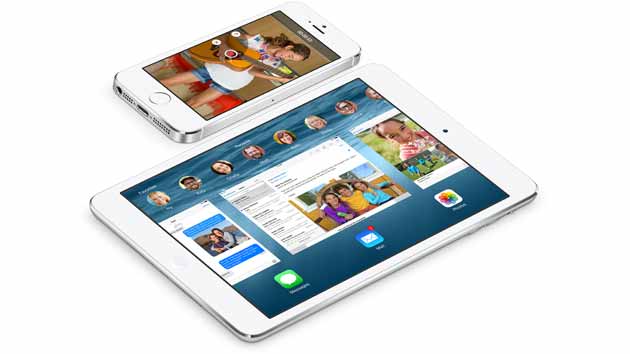A New Programming Language, Third-Party iOS Keyboards, Image Annotation in Email, and More
What's been cooking in Cupertino? Today was the big keynote address at Apple's World Wide Developer's Conference (WWDC), in which Apple CEO Tim Cook rolled out the company's latest and greatest for an audience of software developers — as well as Mac lovers and haters worldwide who tuned in to the live video stream. Apple didn't introduce any new hardware, nor did the company address Final Cut Pro X, concentrating instead on the new features in the forthcoming OS X Yosemite and iOS 8, including a slew of news aimed squarely at programmers. But any improvement to Apple's core products is a boon to the creative pros who gravitate toward iPhones, iPads, MacBooks and Mac Pros in their daily lives. There was a lot of news today for developers, but here's a quick summary of the high points of today's nearly two-hour-long presentation.
Apple is learning to be less of a control freak.
Apple announced a new level of extensibility to applications in iOS, which are normally isolated in sandboxes. Now, applications will be allowed to reach out of their own sandboxes interact with other apps' extensions. Apple showed one extension that allows Bing Translation to do inline translations on web pages loaded in Safari, but the big news for iOS users is that potentially speedier third-party keyboards, like the popular Swype keyboard for Android, will finally be allowed to replace the vanilla Apple-provided keyboard system-wide. That's a major (and very welcome) concession from a company that has historically maintained a stranglehold on user experience.
Programming for OS X and iOS may have just gotten a lot easier.
Apple announced Swift, a new language for developing OS X and iOS applications that replaces Objective-C. At the WWDC keynote, Apple's Chris Lattner demoed a highly interactive development environment in Xcode called a Swift playground that allows programmers to see exactly what they're doing — what different variables represent, or which images are being loaded — as they type in each line of code. Swift code can work alongside C and Objective-C code in the same application, and is completely native to the Cocoa and Cocoa touch development frameworks for OS X and iOS. Judging from the crowd reaction, Swift, which jettisons much of the baggage associated with the venerable C, was the biggest and most welcome surprise of the keynote. If your job description requires you to develop apps for Apple devices, you'll want the just-released eBook
The Swift Programming Language, available for free download through iTunes.
Annotated sharing is hitting the mainstream.
New annotation features in Mail will allow Mac users to grab photos and magnify portions of them, add notes, and/or draw arrows to highlight different regions of interest. The feature is obviously aimed at casual sharing of group photos, vacation snapshots and the like, but filmmakers may find it to be a very handy way to precisely add quick notes to screen shots, giving additional guidance to collaborators in editing, color, or VFX. In addition, Mail will also have a feature built in that allows users to share large files (up to 5 GB) via email using iCloud, rather than overtaxed email servers, to actually move the data around. That's not a game-changer, but it could be a useful shortcut between Mac users.
The iPhone's camera is getting more useful.
Apple is opening its camera API to allow direct manipulation of white balance, exposure, and focus in third-party camera apps. Meanwhile, the built-in Photos app will now offer users much more granular information about parameters like brightness, contrast, and exposure. There's no indication that the camera's video features have been similarly enhanced — although iOS 8 will include a time-lapse mode. The iPhone camera isn't exactly pro quality, but it's certainly not bad, and all of this will only make it a better tool for snapshots.
Mac and iOS users keep themselves up to date.
Apple CEO Tim Cook razzed Google over OS stagnation in the Android user base, claiming that 89 percent of iOS users have upgraded to the new iOS 7, versus just 9 percent of Android users who are on KitKat. In addition, he said that Apple's free OS X Mavericks upgrade has been installed by more than half of the overall Mac user base. That gives developers more incentive to work the latest features of both operating systems into their apps.
Apple's iCloud Drive catches up with Google Drive. And Microsoft OneDrive. And Dropbox …
You get the picture. Apple upgraded its iCloud service for OS X Yosemite by adding a folder called iCloud Drive that syncs with servers on Apple's end, allowing access on iPhone, iPad and even Windows PCs. It'll be yet another handy place for Mac users to store important information that they need to access from multiple locations, but hardly a game-changer.
Your phone is becoming less important as a phone.
An upgrade to iMessage means you don't need to pick up your phone to read and respond to text messages, even if they are being sent from non-Apple devices. Instead, they will be displayed on-screen in the iMessage app for OS X. According to Apple, you won't even have to pick up your phone to make a call. Your phone service can be integrated with OS X so that you can use your MacBook Pro as a speakerphone. That's pretty slick, assuming (big assumption) it all works as advertised.
OS X Yosemite and iOS 8 are available now to registered developers, and will enter general release in the fall. If you want to be a beta tester, Apple is taking sign-ups on the web, saying the first million registrants will be invited to test-drive Yosemite — albeit without some of its most-anticipated features in place — this summer. (You probably don't want to try that on a machine you use for production.)




Leave a Reply